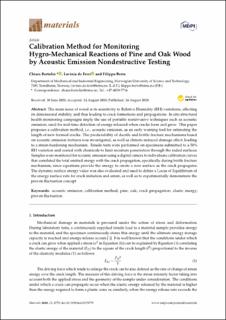| dc.contributor.author | Bertolin, Chiara | |
| dc.contributor.author | De Ferri, Lavinia | |
| dc.contributor.author | Berto, Filippo | |
| dc.date.accessioned | 2020-09-28T08:51:39Z | |
| dc.date.available | 2020-09-28T08:51:39Z | |
| dc.date.created | 2020-09-16T10:44:29Z | |
| dc.date.issued | 2020 | |
| dc.identifier.citation | Materials. 2020, 13 (3775), 1-21. | en_US |
| dc.identifier.issn | 1996-1944 | |
| dc.identifier.uri | https://hdl.handle.net/11250/2679889 | |
| dc.description.abstract | The main issue of wood is its sensitivity to Relative Humidity (RH) variations, affecting its dimensional stability, and thus leading to crack formations and propagations. In situ structural health monitoring campaigns imply the use of portable noninvasive techniques such as acoustic emission, used for real-time detection of energy released when cracks form and grow. This paper proposes a calibration method, i.e., acoustic emission, as an early warning tool for estimating the length of new formed cracks. The predictability of ductile and brittle fracture mechanisms based on acoustic emission features was investigated, as well as climate-induced damage effect, leading to a strain-hardening mechanism. Tensile tests were performed on specimens submitted to a 50% RH variation and coated with chemicals to limit moisture penetration through the radial surfaces. Samples were monitored for acoustic emission using a digital camera to individuate calibration curves that correlated the total emitted energy with the crack propagation, specifically during brittle fracture mechanism, since equations provide the energy to create a new surface as the crack propagates. The dynamic surface energy value was also evaluated and used to define a Locus of Equilibrium of the energy surface rate for crack initiation and arrest, as well as to experimentally demonstrate the proven fluctuation concept. | en_US |
| dc.language.iso | eng | en_US |
| dc.publisher | MDPI | en_US |
| dc.rights | Navngivelse 4.0 Internasjonal | * |
| dc.rights.uri | http://creativecommons.org/licenses/by/4.0/deed.no | * |
| dc.title | Calibration Method for monitoring hygro-mechanical reactions of coated and uncoated pine and oak wood by Acoustic Emission Non-Destructive Testing | en_US |
| dc.type | Peer reviewed | en_US |
| dc.type | Journal article | en_US |
| dc.description.version | publishedVersion | en_US |
| dc.source.pagenumber | 1-21 | en_US |
| dc.source.volume | 13 | en_US |
| dc.source.journal | Materials | en_US |
| dc.source.issue | 3775 | en_US |
| dc.identifier.doi | 10.3390/ma13173775 | |
| dc.identifier.cristin | 1830326 | |
| dc.relation.project | Norges forskningsråd: 274749 | en_US |
| dc.description.localcode | © 2020 by the authors. Licensee MDPI, Basel, Switzerland. This article is an open access article distributed under the terms and conditions of the Creative Commons Attribution (CC BY) license (http://creativecommons.org/licenses/by/4.0/). | en_US |
| cristin.ispublished | true | |
| cristin.fulltext | postprint | |
| cristin.qualitycode | 1 | |

